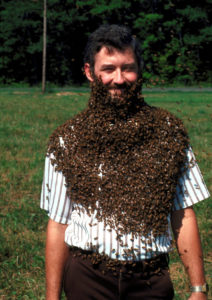Why Bees Swarm
go.ncsu.edu/readext?461772
en Español / em Português
El inglés es el idioma de control de esta página. En la medida en que haya algún conflicto entre la traducción al inglés y la traducción, el inglés prevalece.
Al hacer clic en el enlace de traducción se activa un servicio de traducción gratuito para convertir la página al español. Al igual que con cualquier traducción por Internet, la conversión no es sensible al contexto y puede que no traduzca el texto en su significado original. NC State Extension no garantiza la exactitud del texto traducido. Por favor, tenga en cuenta que algunas aplicaciones y/o servicios pueden no funcionar como se espera cuando se traducen.
Português
Inglês é o idioma de controle desta página. Na medida que haja algum conflito entre o texto original em Inglês e a tradução, o Inglês prevalece.
Ao clicar no link de tradução, um serviço gratuito de tradução será ativado para converter a página para o Português. Como em qualquer tradução pela internet, a conversão não é sensivel ao contexto e pode não ocorrer a tradução para o significado orginal. O serviço de Extensão da Carolina do Norte (NC State Extension) não garante a exatidão do texto traduzido. Por favor, observe que algumas funções ou serviços podem não funcionar como esperado após a tradução.
English
English is the controlling language of this page. To the extent there is any conflict between the English text and the translation, English controls.
Clicking on the translation link activates a free translation service to convert the page to Spanish. As with any Internet translation, the conversion is not context-sensitive and may not translate the text to its original meaning. NC State Extension does not guarantee the accuracy of the translated text. Please note that some applications and/or services may not function as expected when translated.
Collapse ▲Rains have more than replenished soil moisture, as well as filled ponds and lakes. The spring moisture and warm conditions will also have an effect on our honey bees.
Spring is the time when honey bees swarm. When a honey bee colony becomes crowded, they will begin to raise a new queen bee. When this new queen is almost mature, the old queen will leave the hive with about half of the workers bees and some male drones.
This group of bees that has left the hive is called a swarm. They may look intimidating, but they are not a concern for Public Health or safety. A typical honey bee swarm consists of between 10,000 and 40,000 bees. Typically, they will land nearby the old hive, on a tree, shrub, fence post, or even a building.

Honey bees can be very docile. A bee beard is a great example of how honey bees can calm and manipulated. However, anyone alergic to bee stings should keep a safe distance. – Robert W. Matthews, University of Georgia, Bugwood.org
The worker bees cluster around the queen to protect her and keep her warm. Most of the cluster remains largely inactive to conserve energy. However, a number of scout bees are sent out in all directions to search for another suitable home into which their colony can move.
When a satisfactory site has been chosen, the entire swarm of bees will take to the air and move off to their new home. Once inside the new home, worker bees go to work making the new location feel like home. They build new combs for the queen to lay eggs and, for foraging bees, a place to store honey for the colony.
On average, it takes about 24 hours for the swarm to locate a new home. However, a swarm might remain for an hour or as long as 48 hours or more. The amount of time it takes for the swarm to leave is dependent on the scout bees’ ability to locate a good home.
In the old hive, the newly emerged queen bee will make a series of mating flights. Then she will return to her inherited colony and begin to lays eggs to rebuild the colony. She will never leave the hive again unless she, too, leads a swarm to a new home.
Honey bees are not native to the United States. They were brought here by European colonists. Bees are well-adapted to the climate in North America, and, through the centuries, many colonies have swarmed and set up their homes in hollow trees and other suitable cavities. For this reason, bee colonies not living in managed hives are considered to be feral, and not wild.
These feral bees face the same challenges that our managed bees face. These challenges include the varroa mite, small hive beetle, wax moth, tracheal mite, as well as bacteria and viruses that attack honey bees.
For this reason, most swarms that are encountered are from managed hives. There are few feral hives that can survive the challenges alone.
Local beekeepers are interested in capturing swarming honey bees. If you encounter a swarm, you can call our office at 828-757-1290 and we will put you in contact with the beekeepers on our swarm list. The individuals on our swarm list are all seasoned beekeepers that have the knowledge and experience to both capture and tend the bees.
If you have an interest in bees and beekeeping, join other like minded folks on the third Thursday of each month at 6:30 p.m. Meetings are typically held at the Lenoir branch of the Caldwell County Public Library. For additional information, please contact the Caldwell County Extension Center at 828-757-1290 or visit us online anytime at caldwell.ces.ncsu.edu.




